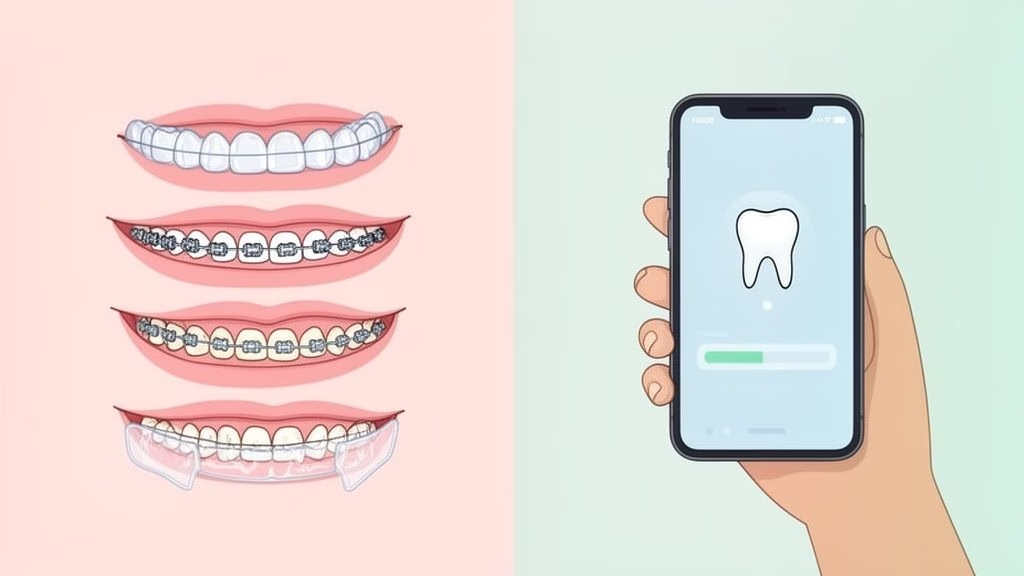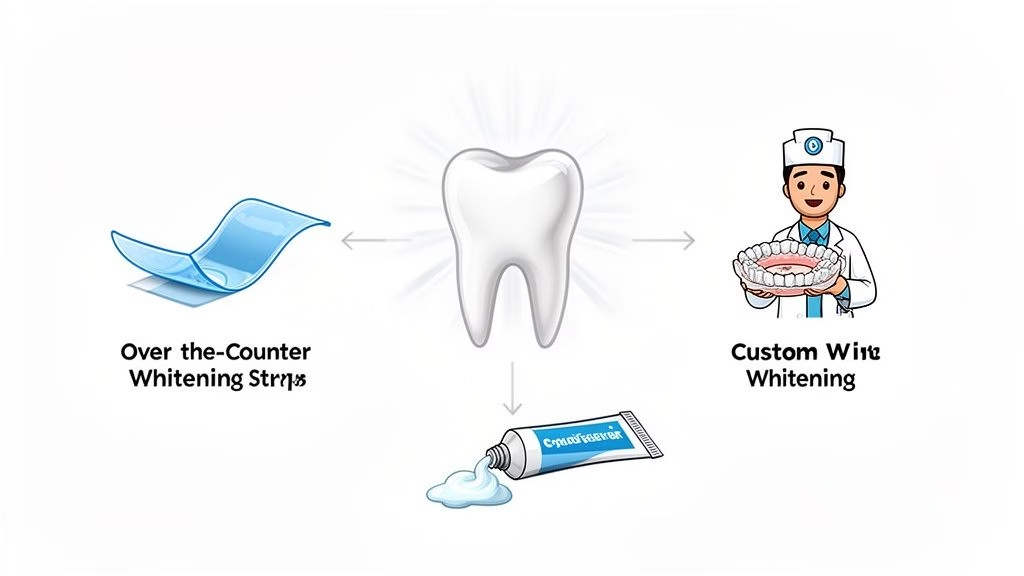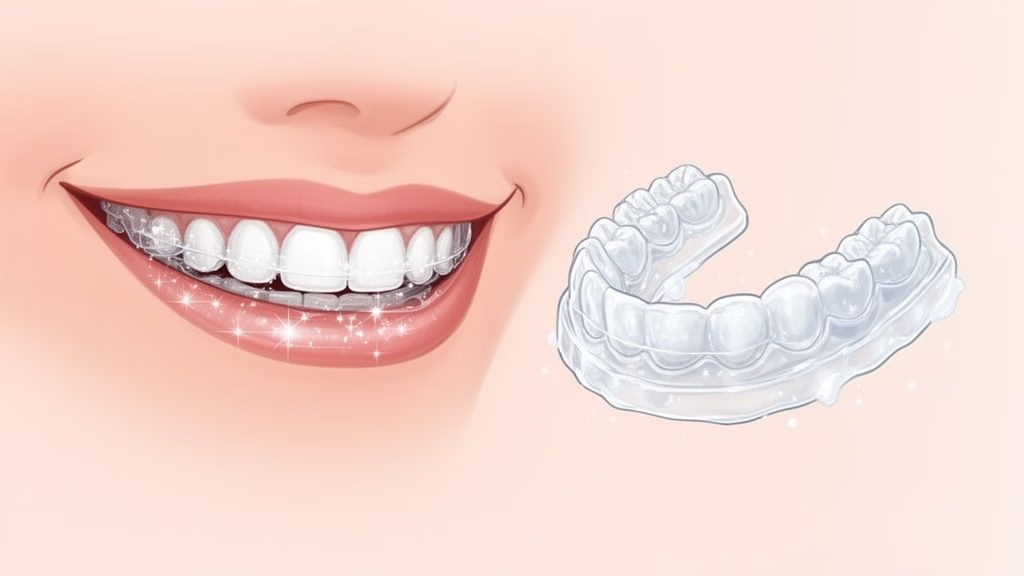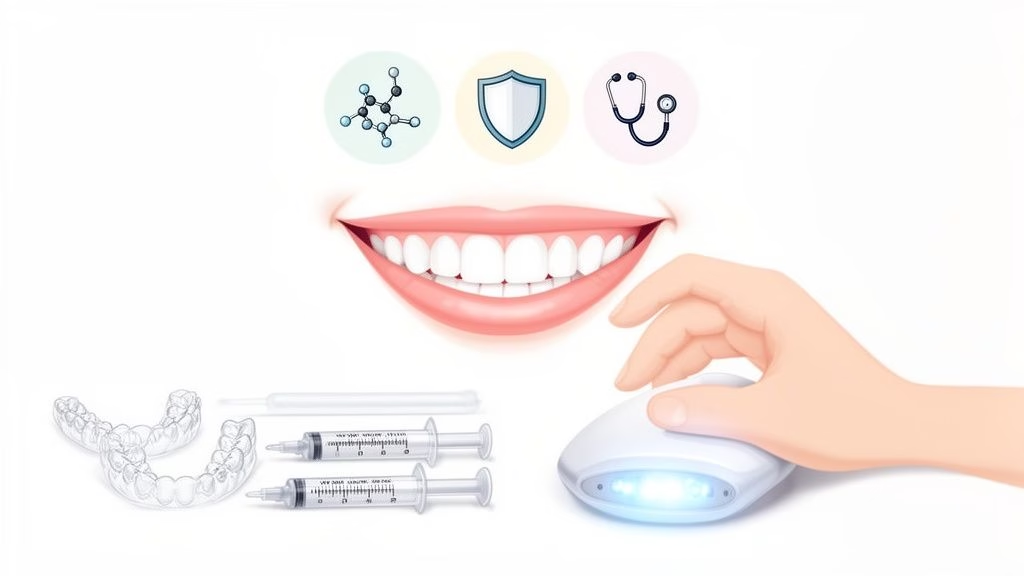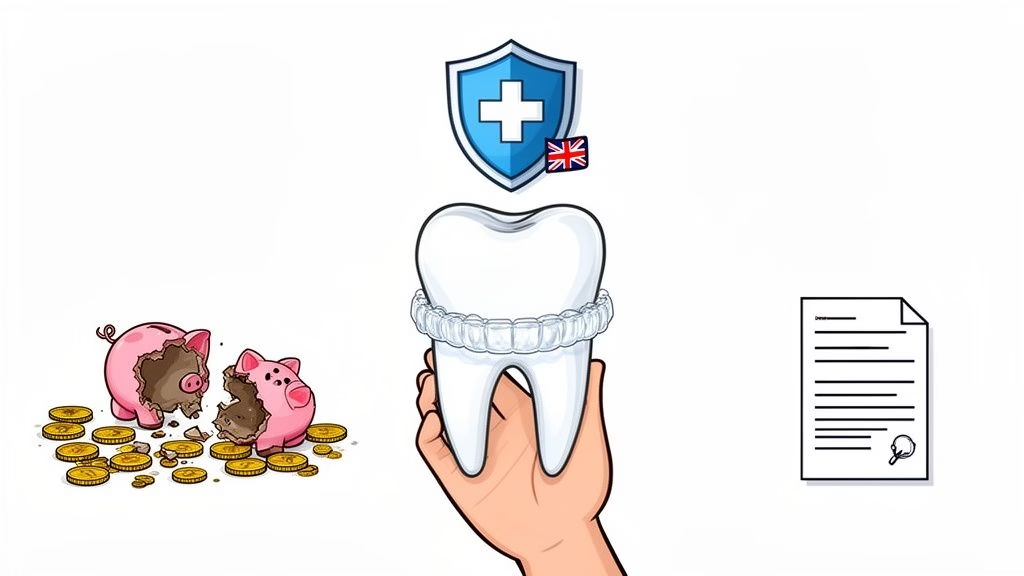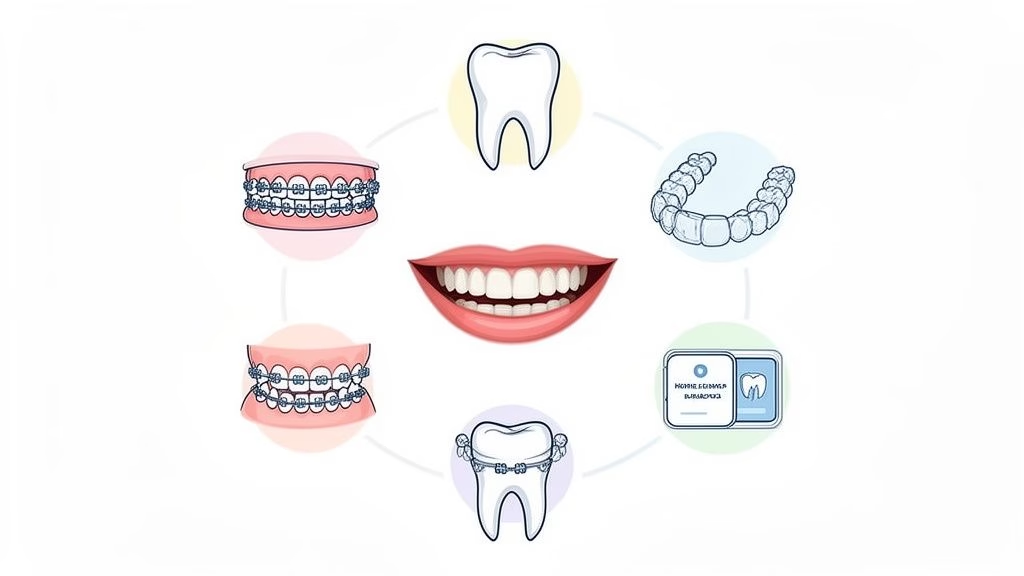How to Get Emergency Dental Care in the UK Fast
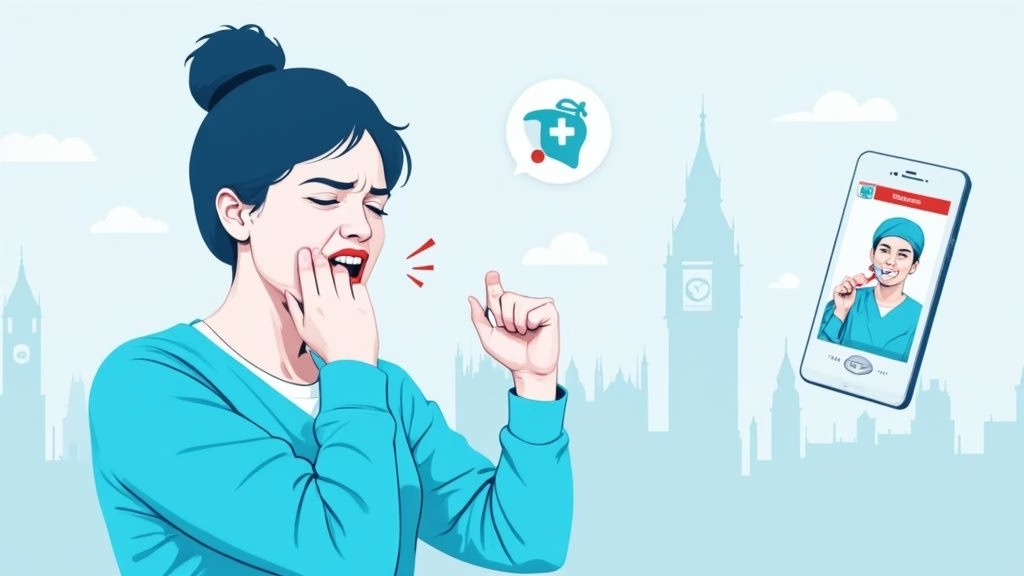
When you're hit with a dental emergency, figuring out your next move—and fast—is what matters most. Whether it's a knocked-out tooth or bleeding you can't stop, the first step is always to assess how serious things are. Then, you need to contact a dentist immediately.
For a really quick professional opinion right from your own home, an app like Toothfairy can be a lifesaver. You can connect with a dentist in just a few minutes, and they'll help you figure out if you need to rush to a clinic or not. It's a brilliant way to get crucial first-aid advice and save yourself a lot of time and worry.
What to Do When a Dental Emergency Strikes

Let's be honest, dental emergencies never seem to happen during office hours. That sudden, throbbing pain or an accident that damages a tooth can leave you feeling panicked and completely lost about what to do. The most important thing is to try and stay calm and work out if you're dealing with a genuine emergency or just an urgent problem that can wait until morning.
A true dental emergency involves symptoms that need immediate attention to save a tooth, stop bleeding, or get you out of severe pain. These aren't just minor niggles; they're serious issues that will only get worse if you ignore them.
Quick Guide Is It a Dental Emergency?
When you're in pain and feeling stressed, it can be tough to think clearly. This table is a quick reference to help you decide if you need immediate care or if you can book a regular appointment.
| Symptom | What It Could Mean | Immediate Action to Take |
|---|---|---|
| Knocked-Out Tooth | A time-sensitive injury requiring re-implantation. | Find the tooth, hold it by the crown, store it in milk, and see a dentist within the hour. |
| Severe, Throbbing Pain | Could be a sign of a serious infection or abscess. | Call an emergency dentist. Don't put it off. |
| Non-Stop Bleeding | Might indicate a serious soft tissue injury. | Apply gentle pressure with sterile gauze and seek immediate dental or medical help. |
| Swelling in Jaw or Face | Often a sign of a spreading infection or abscess. | This is a high-priority emergency. Contact a dentist or go to A&E. |
| Lost Filling/Crown | Exposes sensitive parts of the tooth. | Not an emergency, but book a dentist appointment soon. Use dental cement in the meantime. |
| Chipped Tooth | Can range from cosmetic to serious if the nerve is exposed. | If there's no pain, you can wait. If it's painful, you need to be seen sooner. |
Hopefully, this little guide helps clarify what needs an urgent response and what can wait a day or two.
Identifying a True Dental Emergency
Recognising the signs of a serious problem is the key to getting the right help quickly. If you're experiencing any of the following, it’s time to seek immediate care:
- A severe, persistent toothache that isn't touched by over-the-counter painkillers. This often points to an infection or abscess.
- A knocked-out tooth. Time is absolutely critical here. If you can, find the tooth, hold it by the crown (the white part, not the root), and pop it in a small container of milk until you get to the dentist.
- Uncontrolled bleeding from your mouth after an injury or tooth extraction is a definite sign you need professional help.
- Swelling in your jaw or face. This can signal a serious infection that could spread if it's not treated.
A chipped or cracked tooth might not seem like a big deal, but it can escalate quickly. Even tiny fractures can expose the sensitive inner layers of the tooth, leading to intense pain and a risk of infection.
In these situations, getting a professional opinion fast is invaluable. Rather than waiting for a clinic to call you back, services like the Toothfairy app let you have a video consultation with a qualified UK dentist. They can see what's going on, give you advice on managing the pain, and can even send an e-prescription to your local pharmacy. This gives you a clear, immediate plan while you sort out an in-person visit.
For a more detailed breakdown of different scenarios, you might find this an ultimate guide to dental emergencies really useful.
NHS or Private? Making the Right Choice in a Dental Emergency
When toothache strikes, the first question is always the same: where can I get help, and fast? In the UK, you’re usually faced with two choices: go through the NHS or seek private care. Honestly, the best route for you often comes down to a mix of urgency, what you can afford, and what’s actually available near you at that moment.
For most people, the first port of call for an NHS dental emergency is NHS 111. If you can't get hold of your usual dentist or it’s after hours, they’re the ones who can point you towards an urgent dental service. Their goal is primarily to get you out of immediate pain, so think temporary fixes – replacing a lost filling or starting treatment for a nasty abscess to tide you over.
The Reality of NHS Wait Times
While the NHS is a lifeline, getting an appointment can be tough. The system is stretched thin, especially in so-called "dental deserts" where practices just aren't taking on new patients. This isn't just hearsay; the problem is well-documented.
Even with government promises of 700,000 extra urgent appointments, the figures are stark. Around 25% of patients who needed an NHS dentist in the past two years couldn't get seen. That can mean a long, painful wait. You can read more about the government's plans to tackle the NHS dental crisis, but for now, the waits are a real issue for many.
This decision tree gives you a quick visual guide for those first critical moments.

As you can see, serious symptoms like uncontrolled bleeding or severe swelling mean you need to get help immediately. For less critical problems, you have a bit more time to weigh your options.
The Private Care Alternative
It’s no surprise that many people, frustrated by the queues, end up going private. The biggest draw is speed. Getting a same-day appointment is often possible, which feels like a godsend when you're in agony.
Private dentists also tend to offer more flexible scheduling and might have a wider range of treatments available right away. The trade-off, of course, is the cost. An emergency consultation alone can be expensive, before you even factor in the price of the actual treatment.
The crucial difference often boils down to this: NHS emergency services focus on getting you out of immediate trouble, while private care can often provide a more permanent solution in a single visit, albeit at a greater expense.
But what if you're stuck in the middle, facing a long NHS wait but worried about a hefty private bill? This is where modern solutions like the Toothfairy app come in. It offers a fast, affordable way to get a professional opinion from a UK dentist right from your sofa. Through a quick video call, you can get a diagnosis and even have a prescription sent to your local pharmacy. It’s a brilliant way to bridge the gap, giving you a clear plan of action without the stress of waiting for a call back.
A Modern Fix for Urgent Dental Problems
Let's be honest, trying to get an emergency dental appointment can feel like a nightmare. The long waits and eye-watering costs of traditional routes are the last thing you want to deal with when you're in serious pain. You need help, and you need it fast, affordably, and without the usual fuss. This is where teledentistry completely changes the game, cutting through the red tape to connect you directly with a dentist who can help.
Instead of endlessly waiting for a clinic to call you back or losing hours in a waiting room, you can get a proper diagnosis from a qualified UK dentist right from your sofa. The Toothfairy app was built for exactly this scenario, letting you have a secure video call with a professional, often just minutes after you log on. It's simply a much smarter way to handle a dental crisis.
How Does Toothfairy Actually Help in an Emergency?
When you’re in agony, you don't want a complicated process. Toothfairy is brilliantly straightforward. Once you’ve downloaded the app, you can request an emergency video call in just a few taps. During that call, the dentist will listen to your symptoms, have a look at the problem area via your camera, and give you immediate, professional advice on your next steps.
- Quick Diagnosis: You'll get a professional opinion on what's going on without ever having to leave your house.
- Pain Management Sorted: If it's needed, the dentist can send an e-prescription for things like pain relief or antibiotics straight to a pharmacy near you.
- A Clear Plan: You’ll walk away knowing exactly what to do – whether that means an in-person follow-up is necessary or how to manage the pain until then.
Here’s a glimpse of the app's interface. You can see how easy it is to navigate to the service you need.

As you can see, the design is clean and simple. Finding help for an emergency, exploring cosmetic options, or even looking into teeth straightening is all right there.
But Toothfairy is more than just an emergency lifeline. It's a full-service dental platform in your pocket. For instance, it offers a far more accessible and affordable route to straightening your teeth with clear aligners, giving some of the big-name brands a serious run for their money. Having everything in one place—from emergency help to cosmetic dental work—just makes looking after your dental health that much easier.
What Happens at an Emergency Dental Appointment?
Walking into an unfamiliar clinic when you’re in serious pain can be incredibly daunting. Whether you’ve managed to get an NHS slot, found a private practice, or you're following up after an instant consultation on the Toothfairy app, knowing what to expect can really help take the edge off.
The first thing to remember is that the goal of this visit is simple: get you out of pain and deal with the immediate crisis.
Finding the Source of the Problem
Before they can do anything, the dentist needs to pinpoint exactly what's causing the issue. They'll start by talking to you, asking about when the pain started, what it feels like, and if you’ve had any accidents. Think of it as a bit of detective work.
To see what's going on where the eye can't, you'll almost certainly need an X-ray. It's a completely painless and quick process, but it's absolutely vital for spotting problems like:
- A hidden abscess at the root of a tooth.
- A tiny crack or fracture that’s otherwise invisible.
- The precise position of a problematic wisdom tooth.
This initial diagnostic step is what guides the entire treatment plan.
Focusing on Immediate Relief
Once they know what they’re dealing with, the dentist will get to work on providing relief. It’s important to understand that an emergency appointment is all about triage. It’s not the time for comprehensive or cosmetic work; that comes later. The absolute priority is stopping the pain and stabilising your tooth.
Your emergency treatment is about putting out the fire. It might involve draining a painful abscess, placing a temporary filling on a chipped tooth, or giving you a prescription for antibiotics to clear up an infection. Permanent solutions are usually scheduled for a follow-up visit.
The reality is that dental services, especially in the NHS, are under immense pressure. Urgent care slots are like gold dust. In the 2024/25 period, urgent treatments made up 10% of the 35 million total courses of treatment delivered across England. But even with that demand, only 3.5 million urgent cases could be seen, which shows just how stretched the system is. If you're interested, you can look into the full NHS dental activity data to see the bigger picture.
No matter what, you should leave your appointment feeling significantly more comfortable and with a clear plan for what needs to happen next. This visit is your first, most important step on the road to recovery.
Handling the Bill and Dodging Future Dental Dramas
Let's be honest, a dental emergency is bad enough. The last thing you need is the shock of an unexpected bill on top of it all. Knowing what you might be in for financially can help you think more clearly when you're in pain and under pressure.
An NHS emergency appointment comes with a standard charge, which is a relief, but actually securing one can feel like winning the lottery. Private care is nearly always quicker, but the costs can be steep and vary massively from one practice to another.
Many private clinics know that these things happen unexpectedly and offer payment plans to help you spread the cost. It never hurts to ask what your options are. It's also a smart move to check if you've got any dental cover. Taking a moment for understanding your healthcare insurance is crucial so you know exactly what’s covered before you agree to any treatment.
From Panic Stations to Prevention
Of course, the best way to handle the cost of an emergency is to avoid it altogether. It’s a simple truth: proactive dental care is always cheaper and a lot less painful than emergency treatment. A few consistent habits are your best line of defence against future dental disasters.
When it comes to your teeth, an ounce of prevention is absolutely worth a pound of cure. Most emergencies, like a throbbing abscess or a badly decayed tooth, don't just happen overnight. They're often the result of smaller problems that could have been sorted out easily weeks or months earlier.
Making a few small tweaks to your routine can make all the difference:
- Nail Your Brushing: Are you really brushing for a full two minutes, twice a day? Pay special attention to where your teeth meet your gums.
- Actually Use That Floss: It’s the only way to get rid of the plaque that builds up between your teeth, which is a prime spot for cavities to start.
- Get a Mouthguard for Sports: If you play contact sports, a custom-fitted mouthguard is a tiny investment that can save you from a traumatic and very expensive injury.
- Don't Skip Your Check-ups: This is the big one. Regular visits mean your dentist can catch tiny issues before they have a chance to blow up into a full-blown, painful emergency.
This is where an app like Toothfairy really comes into its own. It makes getting those regular check-ups incredibly straightforward by letting you see a dentist right from your own home. By removing one of the biggest hurdles to consistent care, it puts you back in control, helping you keep your oral health on track and stop problems in their tracks.
Common Questions About Urgent Dental Care

When a dental emergency strikes, it's completely normal for your mind to race. The sudden pain and uncertainty can be overwhelming, but having a clear head helps you make the right moves fast.
What If No Dentist Is Available?
Let's be honest, finding a dentist at short notice can feel like an impossible task, especially if it's after hours or you live in a more rural part of the country. We're currently in the middle of a significant dental access crisis in the UK.
This has created what many are calling "dental deserts," where it's estimated that a staggering 9 out of 10 NHS practices aren't taking on new adult patients. The knock-on effect is jaw-dropping, with some emergency waiting lists stretching beyond 18 months. To get a real sense of the scale of this issue, you can read more about the UK's dental access crisis.
So, what do you do? This is where modern teledentistry really comes into its own.
An app like Toothfairy is an absolute lifesaver here. It connects you directly with a qualified UK dentist through a video call, giving you immediate, professional advice and even prescriptions if needed. It’s the perfect stop-gap to get you through until you can get a physical appointment.
A word of caution: many people's first instinct is to rush to A&E for a bad toothache or a lost filling. Unless you're dealing with uncontrollable bleeding from your mouth, facial swelling that's making it hard to breathe, or a serious facial injury, A&E isn't the right place. They simply aren't set up for dental treatment and will likely just send you away with painkillers and a referral.
Don't get caught out by a dental emergency. Get peace of mind with the Toothfairy app and have a UK dentist ready in your pocket. Download it now at https://www.toothfairyapp.co.uk for immediate access to expert advice.
Last updated on September 12, 2025

Dr. Deepak
ToothFairy Care Team.
Dr. Deepak
ToothFairy Care Team.
